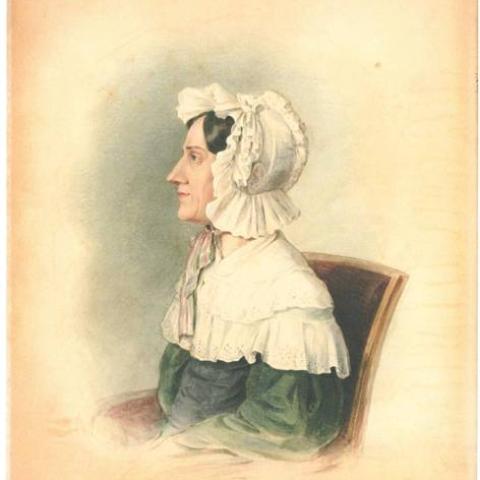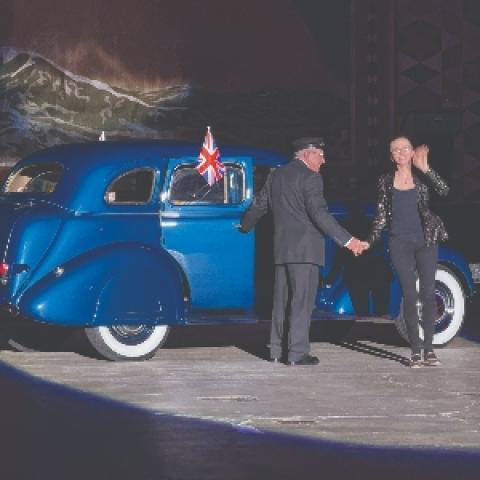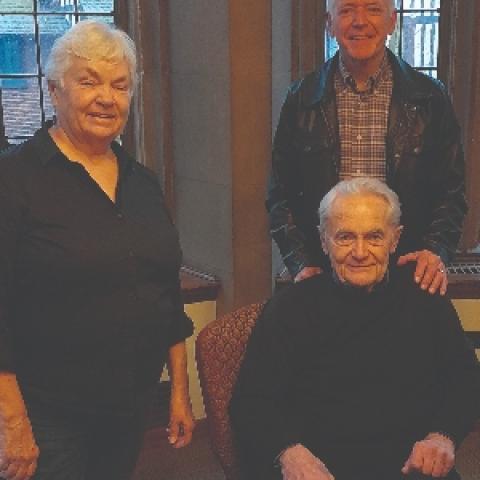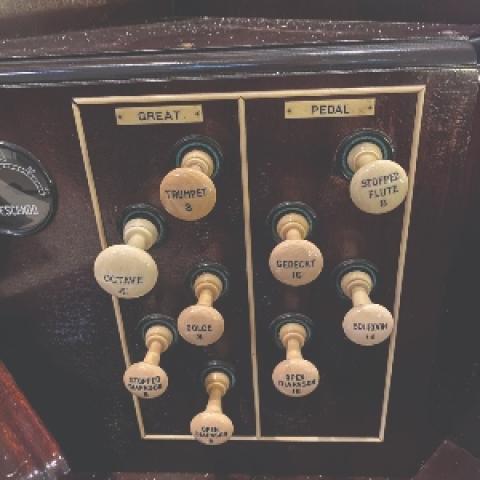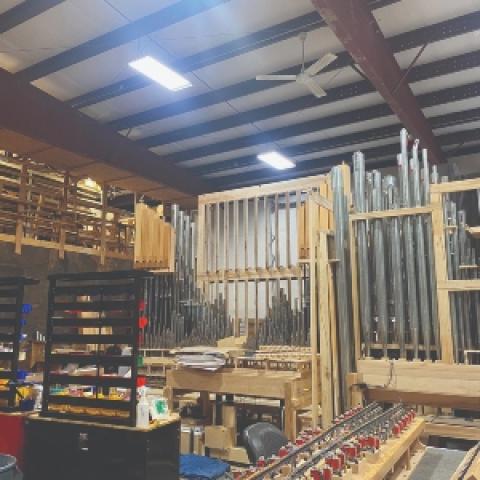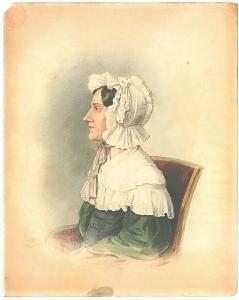
Someone had to do the dishes.
Wendy and I are empty nesters with four grown children between us, three of whom have families with children—our sixth grandchild is due in February. One of those families, with girls ages one and five, was with us last weekend for a rollicking visit. After a raucous and hilarious dinner, the evening before they left (grandpa’s grilled chicken legs with Za’atar were a big hit), mother, father, and grandmother went upstairs to supervise bath time, while I tackled the dishes. I connected my iPad to the Bluetooth speaker in the kitchen and started a favorite recording of mine, Joan Lippincott playing Bach sinfonias with orchestra (Gothic Records) on the beautiful organ with two manuals and twenty-nine stops built by Paul Fritts & Company (Opus 20) in the chapel of Princeton Theological Seminary. Joan presents a variety of Johann Sebastian Bach’s (1685–1750) instrumental movements with organ obbligato and orchestra imaginatively arranged into three-movement concertos.
The cheerful music filled the room as I loaded the dishwasher and packed leftovers (there would be a great lunch the next day), and I marveled anew at the mystery that is our music. These pieces were all written in Leipzig in 1726. Bach was in his early forties and at the top of his game, composing, arranging, rehearsing, and performing a new cantata every week. He played the elaborate organ parts on the three-manual organs in the churches of Saint Thomas and Saint Nicholas in Leipzig, miracle instruments that were the most complex devices of their day.
Organbuilders make intricate charts showing the math involved in making organ pipes with diameters halving at something like every seventeen notes resulting in parabolic lines of the tops of the pipes—all that mathematical precision was developed by Bach’s organbuilders and those who preceded them over the centuries. Eighteenth-century craftsmen made the grids for slider windchests, keyboards, casework, stop actions, key actions, and hand-pumped wind systems using hand tools to transform trees into the intricate and precise pieces and parts that make up any pipe organ. We marvel at all that today, the brilliant sounds and sophisticated tuning systems of instruments made with modern power tools. Bach played on organs with 16′ choruses, complex mixtures, and colorful reeds. The longest days for the people pumping the organ bellows must have been when the tuners were at work. It takes hours to tune a six- or seven-rank mixture with the stable and consistent air pressure from a modern organ blower. I can imagine the organ tuner in Leipzig in 1726 hollering at the pumping assistant to keep the pressure steady, hour after hour.
Put yourself in a pew as an eighteenth-century churchgoer, hearing the “world premiere” of a new Bach cantata every week. Maybe you recognized each as an astounding achievement, but maybe it never occurred to you that it was something special, that generations of succeeding musicians would admire and perform that music. Not to compare myself to Bach, but the oft-repeated comment in the narthex, “The music was great, as always,” seemed sometimes to ring a little false. Did parishioners at the Thomaskirche take their organist for granted?
We listen to performances and recordings of today’s finest players who set high standards of virtuosic musicianship. I wonder what Bach’s music sounded like as he played and conducted it. Were the violinists, oboists, bassoonists, and harpsichordists of Leipzig all brilliant players with pedagogy and techniques like what we are used to, or were they groups of local yokels aswim in the fantastic other-worldly, never-before-seen technical demands of the music of the local master?
Think of the coloratura fireworks of Bach’s Cantata 51, Jauchzet Gott in allen Landen. It is a lifetime achievement for a modern soprano to tackle and master that heap of notes. Was there a parishioner in Leipzig’s Thomaskirche who could toss it off? Maybe she had a couple kids who sang in the choir. I wonder if she had a day job. And do not forget the trumpet part in that piece—the high tessitura with patterns of repeated sixteenth notes to be played on a valveless eighteenth-century trumpet. Was that trumpet player a shopkeeper in real life? Maybe a cop, because he must have been able to whistle like crazy with that embouchure in his face.
There must have been local recognition that something special was going on. How else could the music produced by the local organist of a single church have been preserved and reproduced for the ages?
What were they really like?
Fifty years after Bach wrote those organ sinfonias, Wolfgang Amadeus Mozart’s (1756–1791) creative genius was defining the identity of the recently invented fortepiano. His sonatas and concertos were central to the introduction of the instrument into the musical mainstream. Most of Mozart’s music was performed in private salons and small public halls—at the time of his death in 1796, there were not many concert halls with more than 500 seats. I wonder what those evenings were like. Were people smoking and drinking while Mozart played? Were they talking? Was the piano well in tune? Were servants milling about offering snacks? The 1984 movie Amadeus portrayed Mozart as bawdy, rude, even vulgar. Do we suppose this was based on fact or legend? He was destitute toward the end of his life. Did he show up to play in a fancy drawing room wearing torn and dirty clothes? Did he stuff his pockets with those snacks because he did not have food at home? Did people forgive his unpleasant mannerisms because his music was sublime?
A generation after Mozart, Ludwig van Beethoven (1770–1827) helped transform the piano into a larger-scale concert instrument. As his keyboard technique was growing, he demanded more from the instruments on which he played, breaking strings and grousing about weak tone, once complaining to a piano technician that the instrument “sounded like a harp.” Nannette Streicher (1769–1822) and her brother inherited their father’s piano factory, and while the brother ran the business office, Nannette reengineered their pianos to keep up with the expectations of the burgeoning virtuosity of the day.1 Friedrich Kalkbrenner (1785–1849) was reportedly the first artist to play lightning-fast passages of octaves in both hands, that technique that dazzles and confounds many organists. I can imagine the reaction of the piano technician witnessing that power on an early-nineteenth-century keyboard for the first time.
Nannette Streicher increased the range of the piano, adding octaves at each end of the keyboard. She increased the scale and tension of the strings, beefing up the internal structure to withstand the added pressure, and she developed a new form of keyboard action to propel the dampers toward the strings with greater force. She also built an 800-seat concert hall adjacent to the factory where Beethoven and other virtuosos performed, an important part of the passage from salon musicales toward what we know today as large public performances.
Nannette’s profound contributions to the development of the piano coincided with Beethoven’s advancing the art of playing and writing for the piano. I love imagining their interchanges. Did Beethoven visit her in the factory, looking over prototypes for new designs? It would have been fun to be a fly on the wall. Besides their professional relationship, Nannette was devoted to Beethoven personally, helping him organize his notoriously sloppy household and managing his scraggly finances. We read that he could be irascible, maybe nasty sometimes, but I suppose Nannette was patient and gentle with him. She was the epitome of the full-service piano technician, and she was a brilliant engineer in an age when women were seldom recognized for their professional acumen.
Warm in their PJs, and sent off to bed
Continuing with my after-dinner chores, I put on another of my favorite recordings, Camille Saint-Saëns’ (1835–1921) Second Piano Concerto in G Minor played by Jean-Philippe Collard with André Previn conducting. The second movement, “Allegro Scherzando,” gives insight into the witty, impish side of Saint-Saëns’ personality as it shifts back and forth between different themes and styles with moments of campy “boom-a-chick” rhythmic accompaniments. Remember, this is the guy who included a parody of pianists in Carnival of the Animals, poking fun at the drudgery of practicing scales. He plays another joke in Carnival, offering the nimble and subtle melodies of the “Scherzo” from Mendelssohn’s Midsummer Night’s Dream and Berlioz’s Dance of the Sylphes to be tromped on by the elephantine double basses of the orchestra.
There is a wonderful photograph of Saint-Saëns wearing a voluptuous pair of pajamas, standing on an elaborate carpet and surrounded by ornate decorations, including a bronze statue on a table behind him—it looks as though it might be Rodin. (You can easily find the photo by googling “Saint-Saëns pajamas.”) He is looking sideways out of his eyes, maybe a little suspiciously, as if he is surprised to be caught in his PJs. In his memoir, Recollections (Belwin-Mills, 1972), organist Marcel Dupré shares a few anecdotes about his personal encounters with Saint-Saëns, remembering him as kind and gentle. Studying the many photos and listening to his music, I imagine him as a lot of fun. There is a twinkle in his eye and a twinkle to his music that suggests he knew a good joke when he heard one.
Thinking of the parishioner at the Thomaskirche in Leipzig and wondering if she took for granted the world-altering music she heard every week reminds me of an anecdote told by Clyde Holloway during his tenure as professor at Indiana University as he took a group of students on a study trip to Paris. While the students were in the thrall of Marcel Dupré’s (1886–1971) brilliant improvisation, dazzled by the thrill of it, he noticed a woman sitting in a corner pew with her hands covering her ears. Curious, he went to her and asked if the music was bothering her. “Yes, it’s horrible, and it’s like this every week.”
Bath time is over, and the grown-ups are back in the kitchen for a nightcap and some more chat before bed. I’ll turn the music down now, but it has been fun wondering about the lives and personalities of some of my musical heroes as I cleaned up after dinner. I continue reflecting on the magic that is music. The arranging of musical notes in a certain order, the creation of harmonies by stacking notes above each other, and the progression of harmonies that propel a piece of music toward its conclusion seem other-worldly. The wide variety of instruments we have developed over centuries allows us to bring music to reality in time and space. It is easy to be baffled by the complexity of the organ, but consider the violin, a pound of carefully shaped wood and tensioned strings that can fill a concert hall with sound. Whose idea was all that? We might pay $5,000,000 for a forty-ton organ ($125,000 a ton) while a high-end violin can cost $15,000,000 ($937,500 an ounce). Which is the better value?
I recall my idol, Pythagoras, passing by a blacksmith shop on the Greek Island of Samos around 400 BC, noticing extra tones in the sounds of the anvils, what we know as overtones. His observation led to harmony and melody and the limitless collection of musical timbres we treasure today. But it was flawed mortals—Bach, Mozart, Beethoven, Saint-Saëns, and Dupré—who imagined the music and wrote it down for us to bring back to life.
Well done, good and faithful servant
Brian Jones, long-time director of music and organist at Trinity Church, Copley Square in Boston, Massachusetts, and conductor of the Dedham (Massachusetts) Choral Society, passed away on November 17, 2023, from complications from Parkinson’s disease. He was eighty years old. When I was finishing high school, my father took me to meet Brian for advice about where I should continue my organ playing education. Brian was a graduate of the Oberlin Conservatory of Music, and that is where I went. I was seventeen and he was thirty.
Brian was appointed to his position at Trinity in 1984 and served there until 2004 when he received his appointment as Emeritus Director of Music and Organist. During his tenure, the Trinity Choir achieved national recognition through the release of five recordings including the fabulously successful Candlelight Carols that sold hundreds of thousands of copies and raised the annual Christmas carol service at Trinity to a “must go, standing room only” celebration.
Brian’s twenty-seven-year tenure with the Dedham Choral Society saw the group’s membership increase from twenty-five to 150 singers. Their venues advanced from local church sanctuaries to performances of works like Verdi’s Requiem with full orchestra in Boston’s Symphony Hall. His giant personality and infectious love of music drew people to choirs he led and concerts he presented.
I worked with Brian at Trinity as organ curator for more than ten years starting in 1987. A large part of that work was tuning from 8:00 a.m. to 10:00 a.m. each Friday in preparation for the regular noontime organ recital. I would typically stay for the concert so I could join in the rollicking post-concert lunches at House of Siam, a superb Thai restaurant across Copley Square. Brian was the raconteur at those lunches, regaling the extended table with endless stories, sometimes bawdy, always hilarious. There were many scores of lunches, and I met countless brilliant and fascinating people. “Fridays at Trinity” was a rich education for me about the world of the organ, and Brian was the Dean, leading the laughter.
There were recording sessions scheduled for the wee hours to minimize the intrusion of city noises, and I was always present to correct short-term lapses in tuning or mechanical mishaps. One night, we were interrupted by an immense grating noise from outside just as Brian was starting a take. A machine with a toothed wheel twelve feet in diameter was gnawing a trench in Clarendon Street, and the recording engineer had enough cash in his pocket to convince the crew to keep quiet for the next hours.
The beautiful recording Carols for Choirs was originally produced in-house and was such a success that it would be rerecorded professionally for wider distribution. To make compact discs available for sale before the Christmas shopping season, the recording sessions were in July. It was horribly hot, and the sessions were in the middle of the night. The organ’s many reeds were built and voiced for sixty-eight degrees Fahrenheit, but as the church had no air conditioning, the sultry summer heat brought temperatures to the high nineties in the higher reaches of the organ, and it was not possible to raise the pitch of the reeds enough to match the pitch of the flues. Brian and I had some difficult conversations as I explained the permanent damage that might be caused to the historic, iconic organ pipes, and we experimented with altered registrations to find lovely sounds that were not compromised by the fractured off-season tuning. As the sessions progressed, I lay on the pews, dressed in shorts and t-shirt soaked with perspiration, listening to that superb choir singing the best music of Christmas in July, a treasured absurd memory in the life of an organ tuner.
In December of 2012 I brought a New York colleague to Boston to show him some of the city’s great organs, and we had dinner with Brian in a restaurant on Boylston Street. That afternoon I heard from my son that his wife had gone into labor with our first grandchild, and during the meal I received updates by text message. Ben was born as we were having our last sips as Brian shared stories about his grandchildren.
I am grateful to Brian for encouraging me to study at Oberlin, and I am grateful to him for all the shared experiences at Trinity Church. His friendship and influence were an important part of my appreciation and understanding of the music of the church, and his contributions to American church music seem endless. Rest well, good friend.
Notes
1. I wrote in more depth about Nannette Streicher in the February 2021 issue of The Diapason, pages 10–11.


